Did you know that the average American family uses over 300 gallons of water per day at home? That’s more than 100,000 gallons per year, according to the U.S. Environmental Protection Agency.
To put that in perspective, that’s enough water to fill a small swimming pool every single week.
And much of it? It’s wasted: Running down the drain unnoticed in the background of our busy lives.
But in 2025, as climate change intensifies droughts and global water supplies grow more fragile, this isn’t something we can afford to ignore. Water scarcity is no longer a distant concern. It’s already affecting communities from California to Cape Town. Some areas in the U.S. are experiencing their worst drought conditions in over a century, and experts are warning that water shortages could impact more than 40 U.S. states in the next decade.
The silver lining? You don’t need to overhaul your entire lifestyle to make a difference. With just a few smart, intentional changes, you can reduce water waste, lower your monthly bills, and do your part to protect one of Earth’s most precious resources.
Here are 15 clever, practical ways to save water at home—without sacrificing comfort or convenience.
1. Fix Leaks Immediately
It’s easy to overlook a slow-dripping faucet or a toilet that runs just a little too long. But those tiny annoyances? They add up in a big way. According to the U.S. Environmental Protection Agency, the average household can waste nearly 10,000 gallons of water every year just from leaks.
And just so you know how much water that is, it’s enough to wash about 300 loads of laundry or run your dishwasher daily for over six months.
Nationwide, these household leaks are responsible for nearly 1 trillion gallons of wasted water annually. That’s more water than used by 11 million homes in a year. A worn-out washer in your faucet or a faulty flapper in your toilet could be silently draining your water and money.
The solution is simple but powerful: check your home regularly. Inspect sinks, showers, outdoor hoses, and especially toilets. A trickling sound or a constantly refilling tank is a red flag.
You can even use a few drops of food coloring in the toilet tank if the color seeps into the bowl without flushing, you’ve got a leak. And if you’re not comfortable making repairs yourself, calling in a plumber is a worthy investment. It’s one of the easiest and most impactful ways to conserve water immediately.
2. Install Low-Flow Showerheads and Faucets
Swapping out your old showerhead might not feel like a revolutionary act, but it can make a powerful impact.
WaterSense-labeled fixtures, certified by the U.S. Environmental Protection Agency, are designed to use at least 20% less water than standard models without compromising performance. In fact, they often deliver just as strong (if not better) water pressure, while quietly reducing your water footprint.
The average American family could save around 2,700 gallons of water each year just by installing a WaterSense showerhead. That’s enough water to take more than 80 showers or run 90 full dishwasher cycles. And if every home in the U.S. made the switch, it could save more than 260 billion gallons of water annually.
Beyond the environmental benefits, the energy saved from heating less water means real savings on your utility bills too. The EPA estimates that using WaterSense-labeled fixtures can reduce water and energy bills by up to $140 per year. It’s a small change you can make in an afternoon, with a long-lasting impact.
3. Turn Off the Tap While Brushing Teeth or Washing Hands
It’s one of the easiest habits to build and one of the most overlooked. Letting the faucet run while brushing your teeth, scrubbing your hands, or rinsing dishes might feel harmless, but those extra seconds add up.

Actually, running the tap for just five minutes can waste up to 10 gallons of water. Do that a few times a day, and you’re unknowingly sending hundreds of gallons down the drain every month.
Now imagine this: if every person in the U.S. turned off the water while brushing their teeth, we could collectively save more than 3,000 gallons of water per person each year. That’s a massive win for such a tiny adjustment.
The fix is simple. Turn off the faucet while brushing, shaving, or scrubbing dishes. Use a bowl to rinse produce instead of letting the water run. These small changes cost nothing, take seconds to implement, and can lead to significant water savings over time.
4. Collect Rainwater for Outdoor Use
Why let free water go to waste? Rainwater harvesting is one of the smartest, most sustainable ways to reduce your household’s reliance on municipal water, especially when it comes to your garden, lawn, or even outdoor cleaning.
A single rainstorm can drop hundreds of gallons on your roof, and with a properly placed barrel or catchment system, you can collect and reuse much of that water.
It’s legal in all 50 U.S. states, though some states have specific rules about storage or usage, so it’s worth checking your local guidelines. But in most areas, setting up a basic rain barrel under a downspout is completely allowed and highly encouraged. The EPA notes that rainwater harvesting can significantly reduce stormwater runoff, which helps prevent erosion and water pollution in local waterways.
On average, you can collect about 600 gallons of water from just one inch of rain on a 1,000-square-foot roof. That’s more than enough to keep a vegetable garden thriving or hydrate your lawn without touching the hose. And rainwater is naturally soft, meaning it’s free of the minerals found in tap water—great for sensitive plants.
5. Water Plants Early or Late in the Day
When it comes to watering your garden, timing really does matter. Watering during the hottest parts of the day causes much of the moisture to evaporate before it can soak into the soil. That means your plants stay thirsty, and you end up using more water than necessary.
By simply choosing to water your plants in the early morning or late evening, you allow more of that water to reach the roots, where it’s actually needed.
The U.S. Environmental Protection Agency advises watering before 10 a.m. or after 6 p.m. to minimize evaporation. Doing so can cut outdoor water use by up to 30 percent. In many homes, outdoor irrigation accounts for nearly 50 percent of total water use, so any savings here have a big impact.
Plus, cooler temperatures during these hours help plants absorb moisture more effectively, keeping them healthier and reducing the need for additional watering.
6. Use a Broom Instead of a Hose for Outdoor Cleaning
It might feel satisfying to blast your driveway or sidewalk with a hose, but this common practice wastes a surprising amount of water.
Instead, grab a broom and sweep away leaves, dirt, and debris. Sweeping is just as effective at keeping your outdoor spaces clean, and it requires zero water. This simple habit conserves precious water, especially during dry months when every drop counts.

Plus, sweeping doesn’t send pollutants and debris into storm drains, helping protect your local waterways from contamination.
By swapping the hose for a broom, you reduce water waste and keep your yard looking great. It’s a small change that can add up to big water savings over time.
7. Opt for Water-Efficient Appliances
When it’s time to upgrade your appliances, opting for water-efficient models is one of the smartest moves you can make. Appliances like ENERGY STAR-rated dishwashers and washing machines are designed to use significantly less water without sacrificing performance.
For example, these models use up to 12 gallons less water per cycle compared to conventional machines, which adds up quickly over the life of the appliance. And even more, these appliances also use less energy, allowing you to save energy in your home.
8. Only Run Full Loads of Laundry or Dishes
One of the simplest ways to conserve water is to make sure you only run your dishwasher or washing machine when they’re fully loaded.
Running these appliances with just a few items inside wastes water, energy, and money. Each cycle uses nearly the same amount of water regardless of the load size, so a half-empty machine means water is being used inefficiently.
The U.S. Department of Energy highlights that running full loads can save thousands of gallons of water annually. For instance, doing this consistently could save the average household up to 1,000 gallons of water per month. That adds up to significant reductions in both your water and energy bills over time.
By waiting to run these machines until they are full, you’re not just saving resources. You’re also reducing wear and tear on your appliances, potentially extending their lifespan. It’s a straightforward habit that delivers real benefits for your wallet and the environment.
9. Mulch Your Garden Beds
Applying mulch to your garden beds helps the soil hold moisture by reducing evaporation. This means you won’t have to water as often, saving both water and effort. Mulch also helps keep the soil temperature steady, which is better for your plants’ roots.

On top of conserving water, mulch suppresses weeds by blocking sunlight, so plants don’t have to compete for water and nutrients. Over time, mulch breaks down and improves soil health, making it a simple and effective way to boost your garden while saving water.
10. Choose Native or Drought-Resistant Plants
Landscaping with native or drought-resistant plants is one of the smartest ways to cut down on water use. These plants have evolved to thrive in your local climate, so they naturally need less water than non-native species.
By selecting the right plants, you create a garden that requires minimal irrigation, saving water and reducing your outdoor maintenance time.
Using drought-tolerant plants can reduce your outdoor water use by up to 50 percent. These plants are not only water-wise but often more resilient to pests and diseases, meaning fewer chemicals and resources are needed to keep your garden healthy. This approach makes your yard more sustainable and keeps it looking vibrant even in dry conditions.
11. Shorten Your Showers
Reducing your shower time by just a few minutes can make a big difference in water use. A standard showerhead uses about 2.5 gallons of water every minute.
So, a 10-minute shower can use up to 25 gallons of water. By cutting your shower by 4 minutes, you save around 10 gallons each time you shower. Over days and weeks, this simple change adds up to significant water and energy savings.
12. Reuse Greywater Where Safe
Greywater is gently used water from sinks, showers, and laundry that can be reused for watering plants and landscaping. Recycling this water reduces the amount of fresh water your household uses and helps lower your overall water bill. It also lessens the strain on municipal water supplies and reduces wastewater going to treatment plants.
Before installing a greywater system, it’s important to check local laws and regulations because some areas have rules to ensure safety and proper handling. When done correctly, greywater reuse is a smart, sustainable way to conserve water and keep your garden healthy.
13. Cover Pools to Reduce Evaporation
Uncovered swimming pools can lose a significant amount of water through evaporation, especially in hot or dry climates.
For example, a 400-square-foot pool may lose up to 10,000 gallons of water each year just from evaporation. That’s a huge waste of a valuable resource. Using a pool cover can drastically reduce this loss by preventing up to 95 percent of water evaporation.
Pool covers not only conserve water but also help keep your pool cleaner and reduce the energy needed to heat the water. Covering your pool is an easy and effective way to save water and lower maintenance costs.
14. Educate and Involve the Whole Household
Water conservation works best when everyone in the household gets involved. Teaching family members about why saving water matters helps build awareness and encourages everyone to pitch in.
Simple habits like turning off taps properly, taking shorter showers, or fixing leaks become easier when the whole household shares the goal.
You can make it fun by setting water-saving challenges or goals for your family to reach together. Creating this kind of teamwork not only cuts down water waste but also fosters a culture of responsibility and care for the environment that can last a lifetime.
15. Check Your Water Bill for Sudden Spikes
Keeping a close eye on your water bill is a simple but powerful way to monitor your water usage.
If you notice a sudden spike in your bill, it might be a sign of a hidden leak somewhere in your home, such as a dripping faucet or running toilet. Catching these issues early can save thousands of gallons of water and prevent costly repairs down the line.
By reviewing your bill regularly, you stay aware of your household’s water patterns and can quickly address any unusual increases, helping you keep your water use efficient and your expenses under control.
Conclusion: Small Habits, Big Impact
Conserving water doesn’t require drastic changes—just mindful habits and a commitment to sustainability. By implementing these 15 clever strategies, you can significantly reduce your water usage, lower your utility bills, and contribute to a healthier planet. Every drop counts, and your efforts make a difference.




My partner and I stumbled over here from a different web address and thought I might check things out. I like what I see so now i’m following you. Look forward to finding out about your web page repeatedly.